At a Nippo Show:
Nihinken Hozonkai (Nippo): Translated in English as
Association for Preservation of Japanese Dogs
Association for Preservation of Japanese Dogs
The Nippo objectives;
1. Establish standard of Japanese breeds.
2. Give guidance on breeding of Japanese dogs.
3. Issue pedigree and maintain register.
4. Conduct researches and publish reports.
5. Sponsors shows and seminars.
6. Nominate judges for shows.
7. Introduce Japanese dogs to other countries.
8. Promote Japanese dogs for hunting, pets, etc.
9. Publish official newsletters.

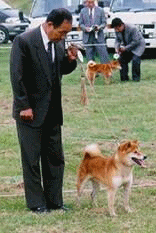
Nippo Local Shows are usually held twice a year on Sundays
in Spring and Fall. The Nippo Grand National Show is
usually held in the mid November over the weekend. In the
shiba inu shows, following six age groups are evaluated:
in Spring and Fall. The Nippo Grand National Show is
usually held in the mid November over the weekend. In the
shiba inu shows, following six age groups are evaluated:
1. Youchiken Kumi (Kinder Class): Small puppies up to 4
months old.
months old.
2. Youken Kumi (Puppy Class): Puppies over 4 months to 7
months old.
months old.
3. Waka Inu I-Kumi (Young Class I): Over 8 months to 12
months old.
months old.
4. Waka Inu II-Kumi (Young Class II): Over 1 year to 1 1/2
year old.
year old.
5. Souken Kumi (Young Adult Class): Over 1 1/2 year to 2 1/
2 year old.
2 year old.
6. Seiken Kumi (Adult Class): More than 2 1/2 year old.
Kinder class and Puppy class are judged only once in the
morning for the soundness of body and temperament. All
puppies judged to be in conformation with the standard are
given "Excellent" rating. Those with faults are rated as "
Good", "Fair" or "Pass". Puppies are judged on their
potential to develop.
morning for the soundness of body and temperament. All
puppies judged to be in conformation with the standard are
given "Excellent" rating. Those with faults are rated as "
Good", "Fair" or "Pass". Puppies are judged on their
potential to develop.
Older classes are judged twice, individually in the morning
and as a group in the afternoon. In the morning session, a
judge would check dogs for conformation to the standard.
Handler should stand behind the dog and try to keep the
dog very still at full attention. All dogs are checked for
dentition and height by assistant judges. Dogs are trotted at
slow gait in triangle so that judge can observe dogs in
motion from all sides. Comparative judging is made in the
afternoon. All dogs in each class are lined up and carefully
compared against each other for placement from the 1st to
the last. This is when Kan-I, Ryousei and Soboku as well as
finer points of the standard are compared.
and as a group in the afternoon. In the morning session, a
judge would check dogs for conformation to the standard.
Handler should stand behind the dog and try to keep the
dog very still at full attention. All dogs are checked for
dentition and height by assistant judges. Dogs are trotted at
slow gait in triangle so that judge can observe dogs in
motion from all sides. Comparative judging is made in the
afternoon. All dogs in each class are lined up and carefully
compared against each other for placement from the 1st to
the last. This is when Kan-I, Ryousei and Soboku as well as
finer points of the standard are compared.
There seems to be a misunderstood notion in the States that
Japanese dogs are faced off at the ring to show Kan-I
quality. The Nippo rule on the manner of showing in the
ring clearly states that "Handler should stand behind the
dog and let the dog take a natural stance. Handler should
take care to avoid fighting and aggressive posture." Overly
aggressive dogs do not have Kan-I and are given demerit
marks at Nippo shows. The Class Merit Awards are given to
top one third of the entries in each class. The top two or
three dogs, depending on the number of entries, from
Souken and Seiken Classes of each sex are judged for the
Best of Sex and the Nippo Merit Awards. The best dog and
best bitch are judged to decide the Best in Show and the
Best Opposite Sex.
Japanese dogs are faced off at the ring to show Kan-I
quality. The Nippo rule on the manner of showing in the
ring clearly states that "Handler should stand behind the
dog and let the dog take a natural stance. Handler should
take care to avoid fighting and aggressive posture." Overly
aggressive dogs do not have Kan-I and are given demerit
marks at Nippo shows. The Class Merit Awards are given to
top one third of the entries in each class. The top two or
three dogs, depending on the number of entries, from
Souken and Seiken Classes of each sex are judged for the
Best of Sex and the Nippo Merit Awards. The best dog and
best bitch are judged to decide the Best in Show and the
Best Opposite Sex.
What are the judges looking for when marking each items of
the score sheet? Mr. Saito, a friend and a judge, once said it
is the total balance of the dog, which gives the judges a
strongest impression. In one of the very old research papers
by Dr. Kume on the Explanation of Standard refers to
importance of body parts as follows. Essential Qualities and
its Expression 15%; Total Balance 10%; Face, Head and
Neck 15%; Ears 8%; Eyes 4%; Front legs 10%; Rear legs
10%; Chest 10%; Back and Hip 8%; Tail 5%; Hair and
Coat 5%.
the score sheet? Mr. Saito, a friend and a judge, once said it
is the total balance of the dog, which gives the judges a
strongest impression. In one of the very old research papers
by Dr. Kume on the Explanation of Standard refers to
importance of body parts as follows. Essential Qualities and
its Expression 15%; Total Balance 10%; Face, Head and
Neck 15%; Ears 8%; Eyes 4%; Front legs 10%; Rear legs
10%; Chest 10%; Back and Hip 8%; Tail 5%; Hair and
Coat 5%.
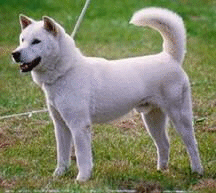
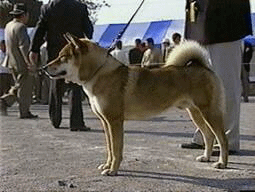
An Excellent Example of Kishuken An Excellent Exaple of Shikokuken
I believe the essence of shiba is expressed from the internal
qualities. Eyes are one of the most important parts to be
checked for such qualities. Ears, muzzle, forehead and
cheeks supplement the expression of eyes. Some may
disagree but I would venture to say that facial expression
centered on eye expression is more than half the shiba. I
believe the expression of internal strength, which include
among others confidence, pride and dignity is what shiba is
all about.
qualities. Eyes are one of the most important parts to be
checked for such qualities. Ears, muzzle, forehead and
cheeks supplement the expression of eyes. Some may
disagree but I would venture to say that facial expression
centered on eye expression is more than half the shiba. I
believe the expression of internal strength, which include
among others confidence, pride and dignity is what shiba is
all about.
Judging in a show is always a controversial issue. As in any
beauty contest, it is almost impossible to be totally objective.
Politics may play a role... The experience and knowledge of
judges are different... Some like it thin, some like it fat...
Given all that, we exhibit the result of our hard work to be
judged by them.
beauty contest, it is almost impossible to be totally objective.
Politics may play a role... The experience and knowledge of
judges are different... Some like it thin, some like it fat...
Given all that, we exhibit the result of our hard work to be
judged by them.
In the final of the Nippo Grand National, a group of judges
score the sheet and vote for the Best of Breed and the Best of
Show. Nippo try to continuously educate and inform judges
on thorough understanding of the standard of Japanese
breeds. There are general meetings of judges every year in
June for such purpose.
score the sheet and vote for the Best of Breed and the Best of
Show. Nippo try to continuously educate and inform judges
on thorough understanding of the standard of Japanese
breeds. There are general meetings of judges every year in
June for such purpose.
It is not easy to be a Nippo judge. First, one must be a
member in good standing for at least five years. If a person
wants to be a judge, he has to be recommended by the local
chapter and be assigned as an assistant judge in chapter
shows for five years. During this period, he needs to take
seminars and tests not only on dogs, shows and standards
but also on general knowledge. He must prove himself to
posses a high moral standard. The person would be assigned
as a judge only after passing the final examination, To
remain a judge he must carry out assignments and
requirements set by Nippo. Personally, I respect anyone
who goes through such long period of apprenticeship and
numerous tests.
member in good standing for at least five years. If a person
wants to be a judge, he has to be recommended by the local
chapter and be assigned as an assistant judge in chapter
shows for five years. During this period, he needs to take
seminars and tests not only on dogs, shows and standards
but also on general knowledge. He must prove himself to
posses a high moral standard. The person would be assigned
as a judge only after passing the final examination, To
remain a judge he must carry out assignments and
requirements set by Nippo. Personally, I respect anyone
who goes through such long period of apprenticeship and
numerous tests.
Notwithstanding the fact that shows are never totally
objective, without shows there are no other ways to assure
breeders that what they have produced is correct according
to the standard. At Nippo, some members strongly feel that
shows are not the end in itself. The purpose of breeding
Japanese dogs for them is to maintain the esthetic value of
Japanese breeds as a cultural heritage and for this end
breeders are looking for more than a big win at the shows.
For them, there is no "Perfect Dog" but only "Ideal Dog".
objective, without shows there are no other ways to assure
breeders that what they have produced is correct according
to the standard. At Nippo, some members strongly feel that
shows are not the end in itself. The purpose of breeding
Japanese dogs for them is to maintain the esthetic value of
Japanese breeds as a cultural heritage and for this end
breeders are looking for more than a big win at the shows.
For them, there is no "Perfect Dog" but only "Ideal Dog".
The 100th Nippo Grand National Show 2003
The 100th Nippo Grand National Show was held in Izumi
Sano city near Osaka on November 15th and 16th. The wide
open space just across the bay from the new Kansai
International Airport was conveniently located for the shiba
fanciers from abroad and a perfect location to celebrate the
centennial Grand National Show. I was amazed at the
record number of overseas visitor this year. It was my
pleasure to meet the shiba fanciers from Sweden, Norway,
Holland, Germany, Spain, Canada and USA. With such
great interest in shibas around the world, my dream of
shibas bred outside Japan winning the Grand National is not
too far away.
Sano city near Osaka on November 15th and 16th. The wide
open space just across the bay from the new Kansai
International Airport was conveniently located for the shiba
fanciers from abroad and a perfect location to celebrate the
centennial Grand National Show. I was amazed at the
record number of overseas visitor this year. It was my
pleasure to meet the shiba fanciers from Sweden, Norway,
Holland, Germany, Spain, Canada and USA. With such
great interest in shibas around the world, my dream of
shibas bred outside Japan winning the Grand National is not
too far away.
For Shizuno and I, it has become an annual event to take a
short trip to near by tourist pots at the time of the Grand
National held in different areas of Japan. This year we took
a trip to Kyoto and visited the mountains of Arashiyama,
famous for its beautiful autumn foliage. November is a high
season in Kyoto. We expected zillions of people visiting
temples and shrines, so we tried to avoid the crowd by
visiting places early in the morning. The autumn foliage at
Arashiyama was not yet in full color this year due to a
strange weather during the summer. Nevertheless, the calm
beauty of Japanese gardens in Arashiyama was a wonderful
place to visit.
short trip to near by tourist pots at the time of the Grand
National held in different areas of Japan. This year we took
a trip to Kyoto and visited the mountains of Arashiyama,
famous for its beautiful autumn foliage. November is a high
season in Kyoto. We expected zillions of people visiting
temples and shrines, so we tried to avoid the crowd by
visiting places early in the morning. The autumn foliage at
Arashiyama was not yet in full color this year due to a
strange weather during the summer. Nevertheless, the calm
beauty of Japanese gardens in Arashiyama was a wonderful
place to visit.
I tried to capture this beautiful moment in a haiku. Haiku,
as the readers may very well know, is a Japanese poem of
short seventeen syllables. It is traditionally associated with "
Kigo", a word signifying seasonality, creating in the minds
of most Japanese an atmosphere of specific season and
poetic feelings. Haiku is not easily translated into English
but I hope the readers could feel the calm atmosphere of late
autumn from this haiku.
as the readers may very well know, is a Japanese poem of
short seventeen syllables. It is traditionally associated with "
Kigo", a word signifying seasonality, creating in the minds
of most Japanese an atmosphere of specific season and
poetic feelings. Haiku is not easily translated into English
but I hope the readers could feel the calm atmosphere of late
autumn from this haiku.
Now back to the show!
In the opening ceremony of the show, Mr. Abe, the Chief
Judge made it clear to the exhibitors that tampering with
hair color will be severely dealt with. He also mentioned
that as explicitly written in the standard of Japanese dogs,
the most favored height is median height for both sexes.
Judge made it clear to the exhibitors that tampering with
hair color will be severely dealt with. He also mentioned
that as explicitly written in the standard of Japanese dogs,
the most favored height is median height for both sexes.
This trend of strict judging on coat color and height was
noticed by the writer in the recent local chapter shows. At
the show in Saitama this fall, I heard an old timer mention
that a maximum height shiba is not likely to win the top
positions. It seems that the exhibitors are very keen to catch
direction of the wind at the shows and plan their breeding
accordingly.
noticed by the writer in the recent local chapter shows. At
the show in Saitama this fall, I heard an old timer mention
that a maximum height shiba is not likely to win the top
positions. It seems that the exhibitors are very keen to catch
direction of the wind at the shows and plan their breeding
accordingly.
Nippo has discussed the issue of light color and soft coat
several times at the annual conference of judges, and agreed
that it is a problem, which need to be corrected. I noticed
that a very showy shibas, with eye-catching urajiro, were
winning more top positions than in the shows ten years ago.
Such shibas stand out in the show ground and breeders and
some judges seem to go for them. I have been aware that
pretty shibas were preferred in JKC shows but never
thought Nippo will go in the same direction. It is good to see
that Nippo judges are now doing something to reverse the
trend.
several times at the annual conference of judges, and agreed
that it is a problem, which need to be corrected. I noticed
that a very showy shibas, with eye-catching urajiro, were
winning more top positions than in the shows ten years ago.
Such shibas stand out in the show ground and breeders and
some judges seem to go for them. I have been aware that
pretty shibas were preferred in JKC shows but never
thought Nippo will go in the same direction. It is good to see
that Nippo judges are now doing something to reverse the
trend.
When Mr. Higuchi was the Chief Judge a decade ago, he
advocated to eliminate sashige (black tipped hairs) on red
coat and established a very strict guideline for sashige. Mr.
Higuchi strongly emphasized clear red color as an ideal
color for shibas. Subsequent to such guideline given to the
judges to eliminate sashige, the number of sesames in the
shows noticeably decreased. Many judges I talked to feel
that in the process of trying to clear the coat color, the
number of shibas with light coat color increased and coat
quality deteriorated, it is not as hard and coarse as required
in the standard. Judges are now getting more lenient on
sashige at shows.
advocated to eliminate sashige (black tipped hairs) on red
coat and established a very strict guideline for sashige. Mr.
Higuchi strongly emphasized clear red color as an ideal
color for shibas. Subsequent to such guideline given to the
judges to eliminate sashige, the number of sesames in the
shows noticeably decreased. Many judges I talked to feel
that in the process of trying to clear the coat color, the
number of shibas with light coat color increased and coat
quality deteriorated, it is not as hard and coarse as required
in the standard. Judges are now getting more lenient on
sashige at shows.
Nippo is encouraging breeders to improve coat color and
coat quality of shibas. Many breeders feel that mating reds
with black and tans without fearing the consequence of
sashige may improve the problem. I believe light yellowish
coat color, with bright urajiro although very flashy and
pretty, spoil the natural beauty of soboku expression. The
word "artlessness" is some times used to define Soboku
quality. It means "natural" and "simple" and never just
pretty. I have translated Soboku as "the natural beauty of
seasoned maturity and modest appearance. Its expression is
the feeling of refined simplicity and sober elegance." By the
way, soboku beauty is often seen in Japanese gardens with
simple arrangement of rocks and moss while Western
gardens are mostly gay with symmetrical, colorful layout of
blooming flowers.
coat quality of shibas. Many breeders feel that mating reds
with black and tans without fearing the consequence of
sashige may improve the problem. I believe light yellowish
coat color, with bright urajiro although very flashy and
pretty, spoil the natural beauty of soboku expression. The
word "artlessness" is some times used to define Soboku
quality. It means "natural" and "simple" and never just
pretty. I have translated Soboku as "the natural beauty of
seasoned maturity and modest appearance. Its expression is
the feeling of refined simplicity and sober elegance." By the
way, soboku beauty is often seen in Japanese gardens with
simple arrangement of rocks and moss while Western
gardens are mostly gay with symmetrical, colorful layout of
blooming flowers.
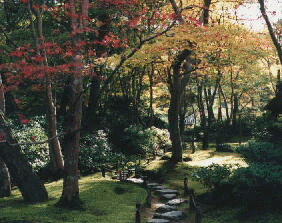
The deep red color is an important part of Soboku quality. I
firmly believe that we should not compromise on coat color
and quality, a very important part of shiba characteristics.
Mr. Higuchi was correct to pursue the ideal clear red color
for shibas, however, it is the breeders who are to be blamed
for deviating from the standard. I hope with the efforts of
Nippo, the current trend for light coat color will be reversed
in a near future. I must add that too dark so-called brick red
color is an unpleasant color and should not be mistaken for
clear deep red color. It is more offensive than light color.
firmly believe that we should not compromise on coat color
and quality, a very important part of shiba characteristics.
Mr. Higuchi was correct to pursue the ideal clear red color
for shibas, however, it is the breeders who are to be blamed
for deviating from the standard. I hope with the efforts of
Nippo, the current trend for light coat color will be reversed
in a near future. I must add that too dark so-called brick red
color is an unpleasant color and should not be mistaken for
clear deep red color. It is more offensive than light color.
The memorable 100th Grand National this year had total of
1,195 entries of which 799 entries were shibas. In my
opinion, the quality of entries this year was better than last
year. The result was very interesting as the winner of
Saikousho (BOB) and the runner up, Jun Saikousho, (BOS)
was brother and sister. I believe it is the first ever to see
brother and sister winning BOB and BOS in the history of
the G. National. The winner of Saikousho was Tetsunishiki
of Kazansou and Jun Saikousho was Suzu no Benihime of
Ondogasetosou. Both Tetsunishiki and Suzu no Benihime
are the son and daughter of Tetsu Arashi of Honjou
Arakisou. Some readers may remember my mentioning of
this stud as a dog to watch in the future.
1,195 entries of which 799 entries were shibas. In my
opinion, the quality of entries this year was better than last
year. The result was very interesting as the winner of
Saikousho (BOB) and the runner up, Jun Saikousho, (BOS)
was brother and sister. I believe it is the first ever to see
brother and sister winning BOB and BOS in the history of
the G. National. The winner of Saikousho was Tetsunishiki
of Kazansou and Jun Saikousho was Suzu no Benihime of
Ondogasetosou. Both Tetsunishiki and Suzu no Benihime
are the son and daughter of Tetsu Arashi of Honjou
Arakisou. Some readers may remember my mentioning of
this stud as a dog to watch in the future.
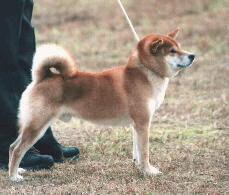
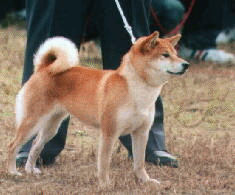
Mr. Shigematsu, the owner of Tetsunishiki, is a good friend
and I have sent my Yuume to him in Kyushu several years
ago to be bred by Tetsu Arashi. One of the pups from that
litter is now with Ms. Birgit Hillerby of Sweden and doing
very well. I talked to Mr. Shigematsu before the show and
he was very modest to say that Tetsunishiki is still young to
win the top position.
and I have sent my Yuume to him in Kyushu several years
ago to be bred by Tetsu Arashi. One of the pups from that
litter is now with Ms. Birgit Hillerby of Sweden and doing
very well. I talked to Mr. Shigematsu before the show and
he was very modest to say that Tetsunishiki is still young to
win the top position.
After the show, when I talked to Mr. Araki, the breeder of
Tetsu Arashi, the happy man was very grateful to his wife
who has been literally his hands and legs. When I asked Mr.
Shigematsu for a few words to the readers of ShibasUSA, he
said that he is very grateful to his mentor Mr. Araki for this
success and advises the breeders in USA to cooperate
together in a group to produce a good shiba.
Tetsu Arashi, the happy man was very grateful to his wife
who has been literally his hands and legs. When I asked Mr.
Shigematsu for a few words to the readers of ShibasUSA, he
said that he is very grateful to his mentor Mr. Araki for this
success and advises the breeders in USA to cooperate
together in a group to produce a good shiba.
At the competition for the best male among the winners of
Seiken A, B and C class, I was pleasantly surprised to see
Iori of Oono Eikeisou from Seiken A class. Iori is the winner
of BOS in the G. National show at Ise two years ago. This
dog is a son of Kamui Go, also a winner of BOB. I liked the
deep red coat on this dog very much and thought he might
be the representative of the males. I am very interested in
how Iori will do as a stud in the future.
Seiken A, B and C class, I was pleasantly surprised to see
Iori of Oono Eikeisou from Seiken A class. Iori is the winner
of BOS in the G. National show at Ise two years ago. This
dog is a son of Kamui Go, also a winner of BOB. I liked the
deep red coat on this dog very much and thought he might
be the representative of the males. I am very interested in
how Iori will do as a stud in the future.
I fully enjoyed the show this year and I am sure the fanciers
from abroad did like wise. Ms. Birgit Hillerby for one was
so excited to see brother and sister of her Tetsu winning at
the show.
from abroad did like wise. Ms. Birgit Hillerby for one was
so excited to see brother and sister of her Tetsu winning at
the show.
|
